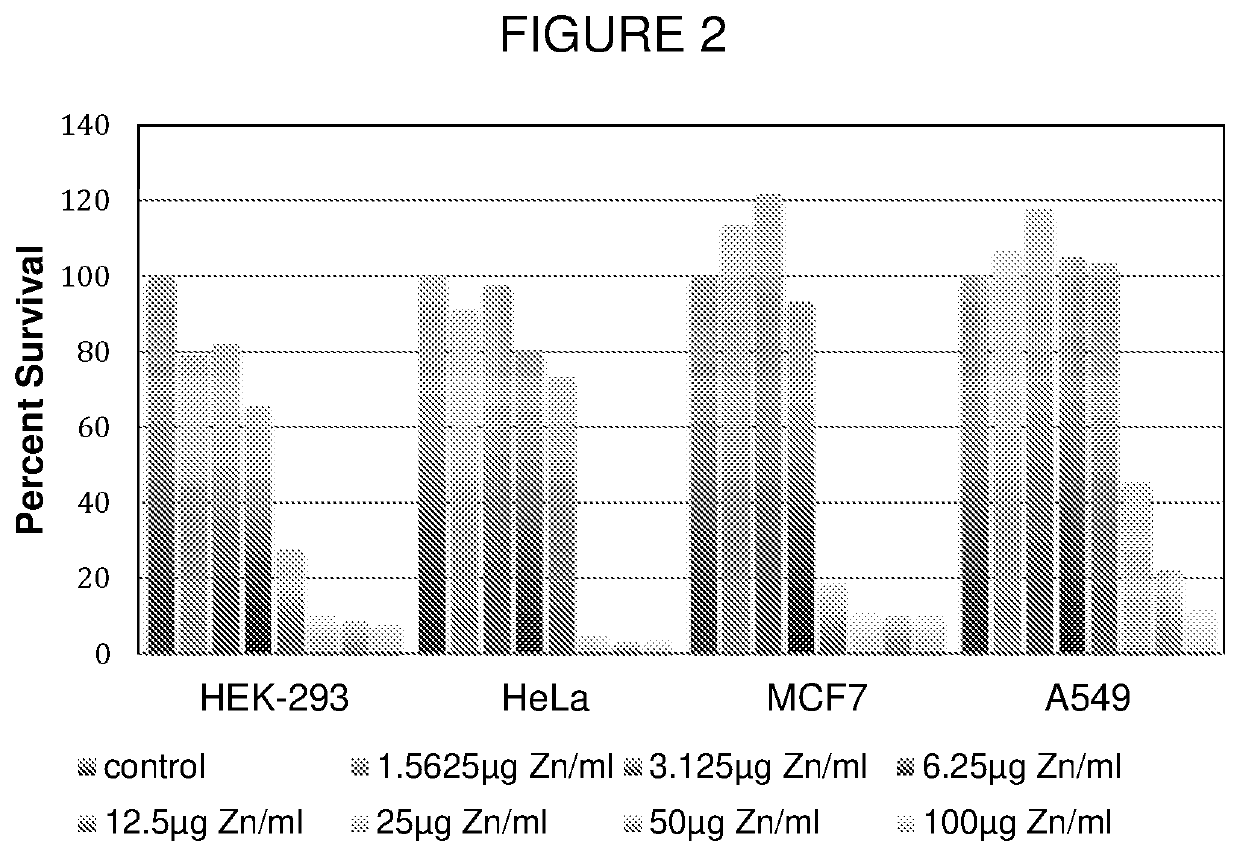Compositions comprising alpha-polyglutamic acid-zinc for treating cancer
a technology of polyglutamic acid and alpha-polyglutamic acid, which is applied in the direction of drug compositions, microcapsules, coatings, etc., can solve the problems of depletion of atp and nadsup>+/sup> in cells, and achieve the effect of preventing, delaying, or attenuating the dissociation of zinc ions
- Summary
- Abstract
- Description
- Claims
- Application Information
AI Technical Summary
Benefits of technology
Problems solved by technology
Method used
Image
Examples
example 1
and Characterizing ZnPGA at pH 7.0 Using Phosphate-Precipitation Method for Removing Non-Bound Excess Zinc
[0114]To prepare ZnPGA, 55 mg α-PGA, sodium salt, 60 kDa average molecular weight (monodisperse) (Alamanda Polymers, Huntsville, Ala.), is dissolved in 5 mL 10 mM MES buffer, pH 7.0, containing 10 mM ZnSO4 at room temperature, and then sonicated while placed on ice for 10 minutes. Then, 0.5 mL 200 mM phosphate buffer, pH 7.0, is added to the solution to precipitate free zinc ions, and the mixture is filtered through a 0.2 μm syringe sterilization filter. The zinc content is measured using ICP-MS and by 4-(2-pyridylazo)-resorcinol assay. Stock solutions of Zn PGA containing, for example, 1% (wt / vol) PGA and 400 μg / mL bound zinc ions may be prepared and used for oral administration.
example 2
and Characterizing ZnPGA at pH 7.0 Using Dialysis Method for Removing Non-Bound Excess Zinc
[0115]To prepare ZnPGA, 55 mg α-PGA, sodium salt, 60 kDa average molecular weight (monodisperse) (Alamanda Polymers, Huntsville, Ala.), is dissolved in 5 mL 10 mM MES buffer, pH 7.0, containing 10 mM ZnSO4 at room temperature, and then sonicated while placed on ice for 10 minutes. Then, the solution is dialyzed on ice against 1L 10 mM MES, pH 7.0, for 2 hours, successively three times, for a total of 3 volumes over 6 hours. The recovered solution is filtered through a 0.2 μm syringe sterilization filter. The zinc content is measured using ICP-MS and by 4-(2-pyridylazo)-resorcinol assay. Stock solutions of ZnPGA containing, for example, 1% (wt / vol) PGA and 400 μg / mL bound zinc ions may be prepared and used for oral administration.
example 3
rmulation
[0116]The composition of an exemplary embodiment of liquid formulation suitable for, e.g., injection comprises a zinc(II) salt, α-PGA, sodium chloride, and water. The composition is prepared by combining zinc sulfate heptahydrate, α-PGA sodium salt, 60 kDa average molecular weight (monodisperse) (Alamanda Polymers, Huntsville, Ala.), sodium chloride and adding water to volume, wherein the concentrations of each component are 1 mg / mL zinc(II), 10 mg / mL α-PGA, and 6.5 mg / mL sodium chloride. The resulting composition of approximately 276 mOsm / kg osmolality and pH 5.68 is suitable for injection in human patients.
PUM
| Property | Measurement | Unit |
|---|---|---|
| Force | aaaaa | aaaaa |
| Volume | aaaaa | aaaaa |
| Volume | aaaaa | aaaaa |
Abstract
Description
Claims
Application Information
 Login to View More
Login to View More - R&D
- Intellectual Property
- Life Sciences
- Materials
- Tech Scout
- Unparalleled Data Quality
- Higher Quality Content
- 60% Fewer Hallucinations
Browse by: Latest US Patents, China's latest patents, Technical Efficacy Thesaurus, Application Domain, Technology Topic, Popular Technical Reports.
© 2025 PatSnap. All rights reserved.Legal|Privacy policy|Modern Slavery Act Transparency Statement|Sitemap|About US| Contact US: help@patsnap.com


